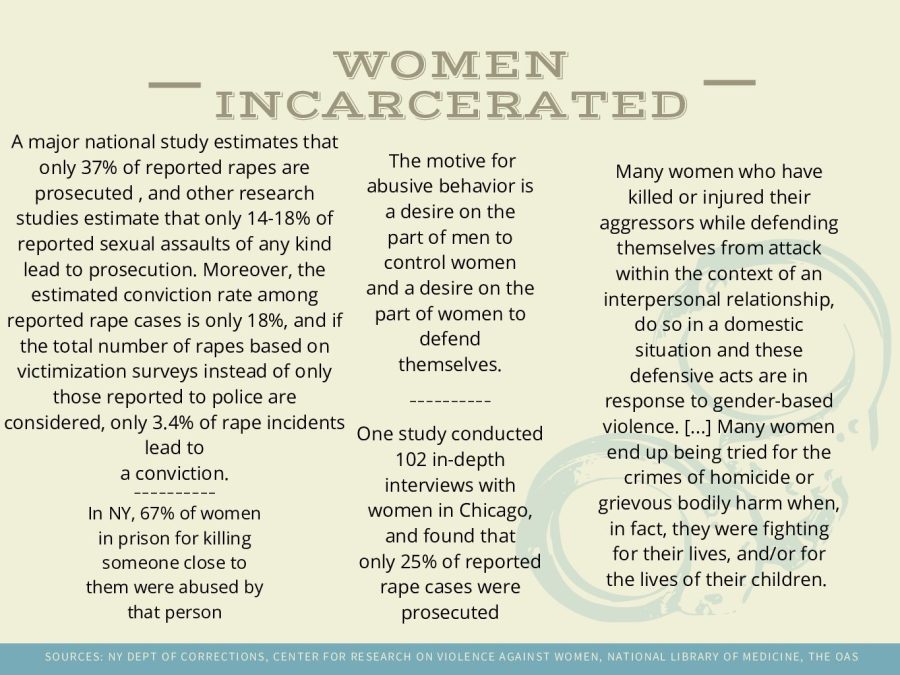Rittenhouse v George: The Fight on Self-Defense
After the decision surrounding Kyle Rittenhouse was released, the same justification did not hold for Maddesyn George
November 29, 2021
Some images stay in your mind forever—memories of time spent with loved ones, the cutest cat videos from the edges of the internet, and a 17-year-old carrying an AR-15 haunting the streets of Kenosha, Wisconsin during a protest against police brutality on Aug. 25, 2020.
Kyle Rittenhouse traveled from Antioch, Illinois to attend the protest—armed. The night ended in Rittenhouse shooting three people. He killed two, Joseph Rosenbaum, 36, and Anthony Huber, 26, and injured one, Gaige Grosskreutz, 27. Rittenhouse said he attended the protest to protect businesses from the riots.
Rittenhouse argued the firing of his weapon was in self-defense after the men attacked him. Rittenhouse was charged with several crimes and misdemeanors: count one of first-degree reckless homicide, count two and three of first-degree recklessly endangering safety, first degree intentional homicide, attempted first degree intentional homicide, possession of a dangerous weapon by a person under 18, and finally, failure to comply with an emergency order from state or local government.
The first argument is whether or not Rittenhouse should’ve had access to the weapon in the first place. Rittenhouse, now 18, was 17 at the time of the alleged crimes. This makes it illegal for him to own a firearm. It is indisputable that Rittenhouse was a minor at the time and that he possessed and used a firearm, but in order for Rittenhouse to be guilty, the prosecution needed to prove that the possession of the firearm was illegal. Rittenhouse and his friend, Dominic Black, who is above the legal age required to own a firearm, testified that Rittenhouse gave Black money to purchase the weapon which he would hold until Rittenhouse turned 18. Rittenhouse picked up the weapon from Black the night of the protest. At first glance, the law seems clear: “Any person under 18 years of age who possesses or goes armed with a dangerous weapon is guilty of a Class A misdemeanor.” A dangerous weapon can be defined as a firearm, even if it wasn’t loaded. The defense pointed out a subsection of this Wisconsin law: minors can possess a firearm as long as it’s not short-barreled. Unfortunately for the prosecution, Rittenhouse’s AR-15 met the minimum requirement to be classified as a long-barreled weapon. As a result, the judge dropped the charge.
The second argument is whether or not Rittenhouse acted in self-defense by law. The law seeks to answer five questions before self-defense can be argued. Firstly, it must be determined that the use of deadly force must be proportionate to the threat. One cannot use deadly force in response to a punch or name-calling. Secondly, the use of self-defense must be in reaction to an immediate threat. For example, one cannot seek out someone and shoot them in revenge and claim self-defense. Third, the individual’s assessment of danger must be reasonable. Fourth, the law does not permit a first aggressor to benefit from a self-defense justification. This means that the individual cannot instigate the situation. Lastly, the use of deadly force must be a last resort; the individual must try to retreat first, as long as it can be done safely. In each of the three situations Rittenhouse was involved in, he testifies he believed he was in imminent physical danger. Mark Richards, one of Rittenhouse’s attorneys, said Huber tried to attack Rittenhouse with a skateboard. In another instance, Rosenbaum acted “irrational and crazy” when he chased Rittenhouse and tried to take away his gun during their fatal encounter, according to Richards. And he said Grosskreutz had a gun in hand when he approached Rittenhouse. All of these claims are supported by multiple witnesses and sources of evidence. The prosecution is responsible for meeting the burden of proof, which, in a criminal case, is beyond a reasonable doubt. The nearly all-white jury decided that this burden was not met, voting in favor of not guilty on all charges.
The news of this verdict broke to a varied audience. While some believed justice had been served, others saw Rittenhouse’s guilt as more than obvious. Kenneth Ray McCain, a veteran, disagrees with the jury’s decision: “If you arrive armed to a place where violence is happening, prepared for violence, and you engage in violence, there is no self-defense, you are in fact, a willing combatant,” McCain wrote. Whether or not Rittenhouse’s actions are morally acceptable, in the eyes of the law, Rittenhouse’s possession of a firearm was indeed legal and his actions were decided by a jury to be in self-defense.
But Rittenhouse’s acquittals beg the question: what about all the women in jail for killing their rapists in self-defense? Just two days before the Rittenhouse verdict was reached, Maddesyn George, 27, sits in a courtroom as she waits to learn how long she will be sentenced to prison after shooting the man who raped her.
George was at her friend Kristopher Graber’s house in July of 2020 when he got on top of her and raped her. When she protested, he pulled out a gun. When Graber later fell asleep, George took the gun from Graber and escaped. The next day, Graber, armed with a shotgun, went out looking for George and found her in a locked car with the window open. Witnesses testify Graber hit George. George shot him once through the window and killed him. George was sentenced to prison. Revisiting the five elements of self-defense, it is clear that George met every one of them. The force was proportional; George was threatened with a firearm and raped in the safety of her own community by a friend. Then, he threatened her a second time with a firearm and hit her. It was an immediate threat; George did not seek out Graber. She shot in response to her fear of his finding her, armed with a shotgun. The individual’s assessment was reasonable; if a perpetrator harms an individual, it is reasonable to assume they would do it again, especially considering Graber was in possession of a firearm. George is not the instigator; she did not initiate or take part in any crime, nor did she seek out Graber afterwards. Unlike Rittenhouse, she did not even leave her community. Lastly, the use of deadly force was a last resort; George first attempted to escape the situation without causing harm to Graber. Yet, even with each element met, clearer than Rittenhouse, George’s plea of self-defense did not hold.
So, what’s the difference between Rittenhouse and George? The answer is simple: the defense. Rittenhouse, a white male murderer, is a stark contrast to George, a Native woman and victim of rape by a law enforcement officer. It is no secret that sexual assault and rape cases rarely hold in the court system, and fewer times still that a woman who killed in self-defense was given an innocent verdict. The difference in Rittenhouse and George’s cases is that George is a victim of judicial racism and a long history of misogyny, while Rittenhouse pleads on the stand of the patriarchy.


